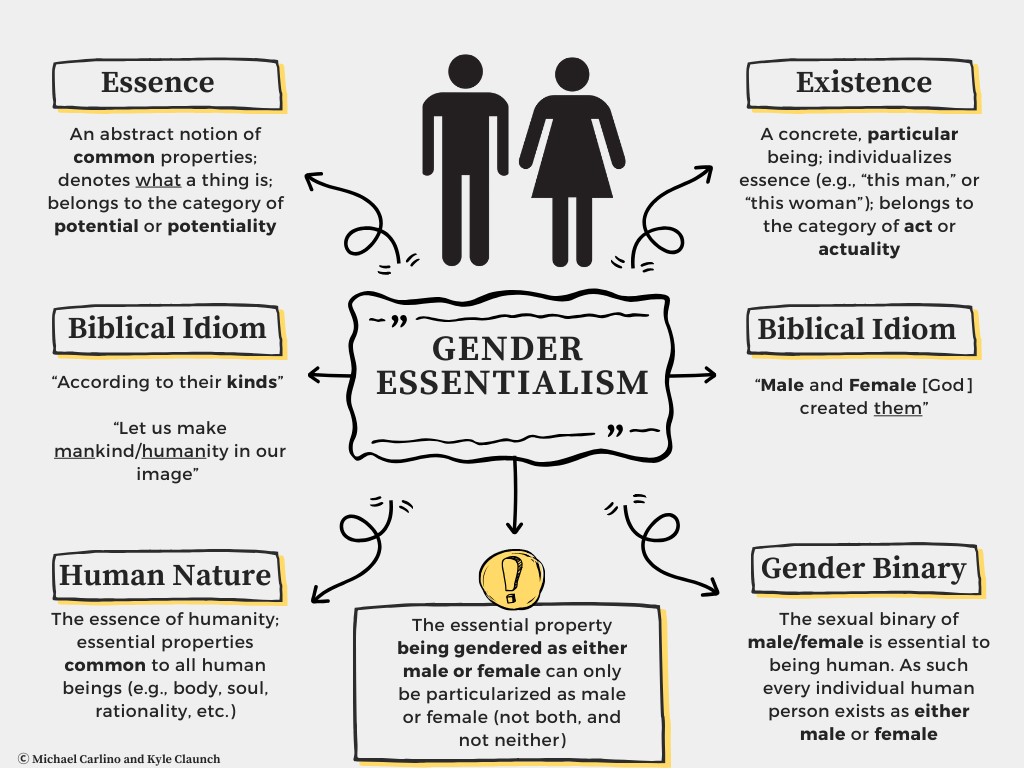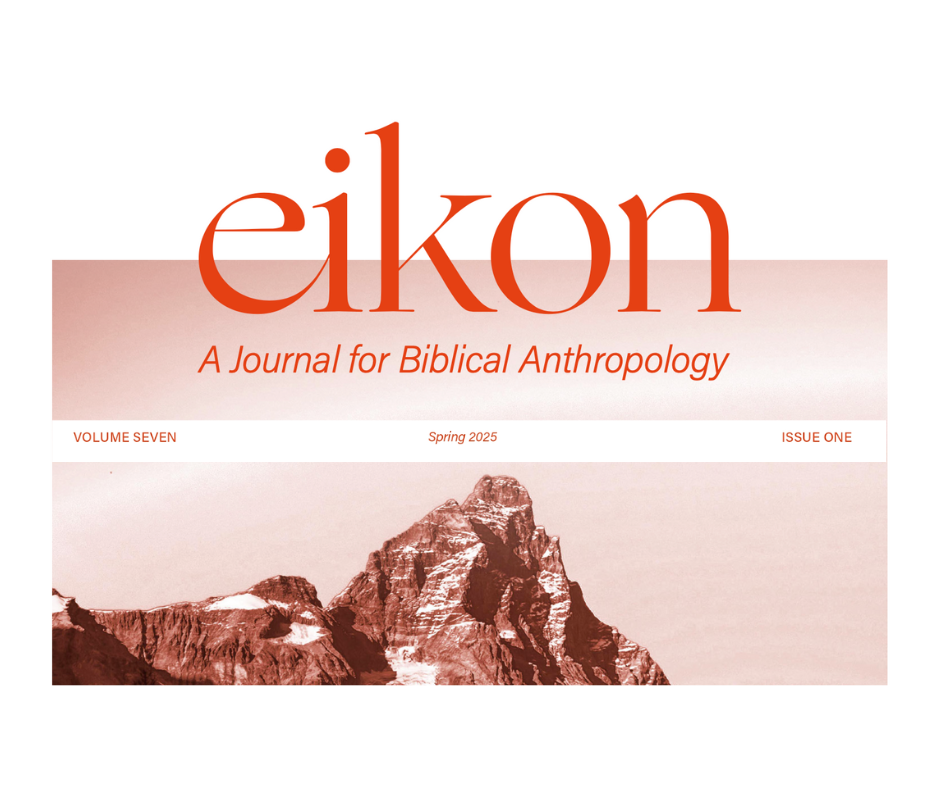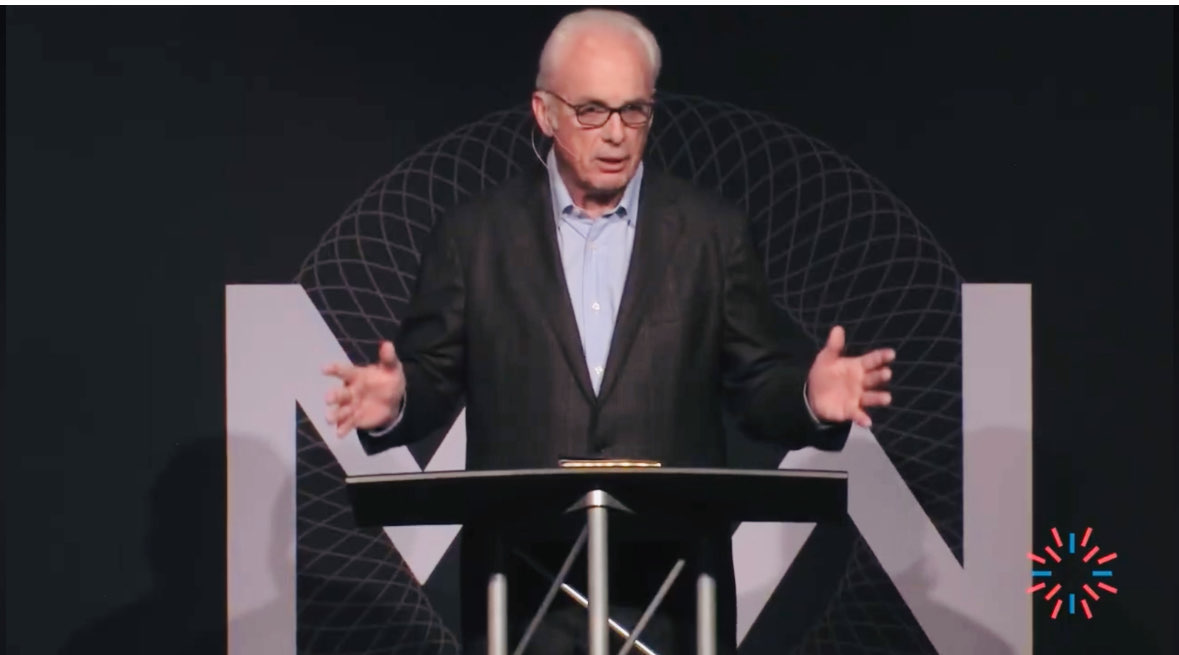Editor’s Note: The following article appears in the Spring 2025 issue of Eikon.
In this essay, we seek to provide a clear and robust dogmatic foundation for a distinctly Christian anthropology, one that coheres with critical covenantal distinctions and pressing Christological concerns.[1] We are convinced a lack thereof is plaguing the discourse on this matter in broader Protestant and Evangelical circles. Our thesis is that the classic distinction between essence and existence is the best conceptual tool for articulating an account of gender essentialism for the following three reasons. First this framework is particularly suited to demonstrate the equality of men and women as sharers of the same essence. Secondly, it allows us to demonstrate that only men are called by God to be covenant heads, as maleness is a precondition to serve in this capacity. Finally, this account of gender essentialism lays a firm dogmatic foundation for upholding the fittingness and necessity of the Son of God’s assumption of humanity as a male for us and our salvation.
Getting Gender Essentialism Right
To begin, it is necessary to give some account of gender essentialism.[2] We are convinced that a sexual binary of male/female is essential to being human. As such, every individual human person is either male or female. We believe this to be the clear teaching of holy Scripture.
Exegetical Observations: Genesis 1
In the Genesis account of creation, God makes each living thing “according to its kind” (Gen 1:11, 21, 24). Each animal kind created consists of a reproducing pair of male and female. When God creates the sea-dwelling creatures and the birds of the sky “according to their kinds” on the fifth day, we read, “And God blessed them, saying, ‘Be fruitful and multiply and fill the waters in the seas, and let birds multiply on the earth’” (1:22). When God creates mankind in his image on the sixth day, he makes them “male and female” and says to them, “Be fruitful and multiply” (1:28).
Two observations are important for our purposes. First, living things can be categorized into types that are broader than and inclusive of individual existing creatures. This is clear from the fact that different kinds of things are created, each kind including at least two individuals from the first moment of their creation. Thus, the biblical creation account demands our affirmation of what later thinkers would refer to as universal natures, or essences, as distinguished from individual instances, or existing things. There is a kind of thing, the properties of which necessarily characterize the individual instances of the kind. If each living being is created “according to its kind,” then the kind functions as a pattern according to which the existing thing is fashioned by God.
Second, being gendered as either male or female is a necessary property of the kind of living beings identified on days four through six of creation week. It is clear that male and female individuals in a reproducing pair belong to the same kind, since having been created according to their kinds, they are “fruitful and multiply.” This is made most explicit in the account of the creation of mankind: “He created them male and female” (Gen 1:27). Both the male and the female are clearly identified as mankind in the previous verse (v. 26). We must, therefore, include the idea of gender in our conception of what constitutes the universal kind.
Stating this coherently requires some careful thought. Neither maleness nor femaleness, as such, can be identified as a necessary property of the kind. Otherwise, the other gender/sex would be excluded, and the reproducing pair would not be of the same kind. The male would be his own kind and the female her own kind, which is not what the text of Genesis 1 indicates is the case. It seems the only coherent way forward is to recognize that being gendered as either male or female is a necessary property of the kinds of living beings identified on days four through six of the creation week. This is what we mean when we say that a gender binary of male/female is essential to being human.
Dogmatic Elaboration: Essence, Existence, and Gender Essentialism
The notion that things exist according to the common properties of a universal kind, and that the properties of one kind differentiate it from another kind, has been recognized by philosophers throughout human intellectual history, even traditions whose key thinkers may have known nothing of the text of Genesis or the rest of Scripture. Christian theologians throughout history have been the beneficiaries of the precise categories and terms of philosophical reflection in their articulation of this biblically revealed truth. Seeking to glean the best insights from his own philosophical heritage, Thomas Aquinas articulated a precise distinction between essence and existence.[3] This essence-existence distinction became a mainstay in Christian theological reflection for centuries to come and can rightly be identified as classical for its frequent appearance in the late medieval period and throughout the periods of post-Reformation Protestant Orthodoxy.[4] We find this distinction to provide precise conceptual terminology to articulate biblically revealed judgments concerning humanity and gender.[5]
Essence, as we deploy the term here, corresponds closely (if not exactly) with the understanding of kind suggested above in our analysis of the Genesis account. Essence is an abstract notion of common properties by which a being is what it is. Existence, on the other hand, is the individual instantiation of essence. Aquinas develops this key distinction most fully in his doctrine of God, especially the article on divine simplicity.[6] All created things are composed of essence plus existence. God, on the other hand, being the first efficient cause of all things (creation ex nihilo), is not composite in any way and is, therefore, not composed of essence plus existence. God’s essence is identical to his existence.[7] While we heartily affirm this account of divine simplicity, including the denial of a distinction between essence and existence in God, the focus of our essay is on the doctrine of humanity where this distinction is very real.
All existing humans are the same with respect to essence, so they can only be distinguished in terms of their individual existence. Distinction between individuals of the same essence can be accounted for in two ways. First, all individuals are distinguished by the particularity of their essential properties. Take rationality, for example. All humans are rational beings, as rationality is an essential property of humanity. But this co-authored essay is written by Kyle and Michael, two males with two distinct rationalities. No matter how much one of us may wish to have the other’s mind, it remains the case that we have our own mind and no one else’s. Thus, we share the essential property of rationality while each possessing our own rational mind. The relation of rationality to this or that rationality is ultimately the same as the relation between essence and existence. The second way that beings of the same essence are distinguished is by their accidental properties. While essential properties name those characteristics that are necessary to being a particular kind of thing, accidents are the properties by which an existing being can change while remaining the same kind of thing. The accidental properties of one existing individual differentiate it in a great variety of ways from other individuals of the same kind. Such properties as size, strength, location, relations, etc. can all change without a change in essence, and all serve to differentiate one existing being from others of the same kind.[8]
Gender as Essential, Not Accidental
How exactly does the issue of gender map onto this discussion? Some might be inclined to say that the particularity of maleness and femaleness represents a distinction of accidental properties. This would suggest that gender is something that admits degrees or may change without altering the essence of the being. We believe identifying gender as an accidental property would be a fatal flaw because of the way the biblical creation account includes both male and female in the kinds of beings that reproduce in the world, a fact made most clear with respect to the creation of mankind, as argued above.
Recall, however, that there is another, more fundamental way that existing beings of the same essence can differ — particularization of essential properties. Because of the strictures of the Genesis 1 account of creation, we contend that being either man or woman is a case of the particularization of an essential property. The essential property being gendered as either male or female can only be particularized as male or female (not both, and not neither). In saying all this, we are contending that gender is an essential property of humanity. This is what we mean by our affirmation of gender essentialism.

Scripture depicts the ontology of created things in a way that corresponds to the classical distinction between essence and existence. In the next section, we take up the important theological issue of covenant headship as it relates to gendered humanity, specifically as this corresponds with the maleness of Adam and Christ as the federal representatives of the Covenant of Works (CoW) and Covenant of Grace (CoG) respectively.
The Fittingness of Male Headship in the Covenant of Works and the Covenant of Grace
The essence-existence distinction from the previous section is both assumed and confirmed in God’s covenantal dealings with humanity in Scripture. We maintain that the Bible teaches male and female equally share in their status as image bearers according to human essence (Gen 1:26–28); and it is only men who are properly and fittingly covenant heads, not women (Gen 2:7; 15–17). Significantly, Adam is the covenant head of Eve in two respects: (1) he is universally the federal head for the entire human race (Eve included); and (2) he is exclusively Eve’s head according to God’s design in the covenant of marriage (Gen 2:20–25; Eph 5:22–33). Adam’s headship is typological in both respects, as his headship over Eve in marriage is the norm for all subsequent marriages,[9] and according to the Apostle Paul, is itself a type of the Christ-church union (Eph 5:31–32). Moreover, Adam’s federal headship in the CoW over all humanity is a type of Christ’s headship over his elect in the CoG, such that in the CoW Adam is a pattern for the Last Adam; and as thus, being male is a necessary precondition by God’s appointment for representing humanity before God.
At its most basic level, a covenant is a formal arrangement between at least two parties. In the Bible covenants are not natural arrangements, but involve promises freely given or conditioned upon a specified action on the part of the covenant partner with whom God condescends to oblige himself.[10] As heirs of the Reformed tradition, we are convinced God’s covenants carry the progress of revelation across the canon of Scripture. Reformed theology traditionally affirms the CoW[11] and the CoG.[12] Though there is much debate regarding how the biblical covenants (i.e., Noahic, Abrahamic, Mosaic, and Davidic) fit within these two arrangements,[13] what is largely agreed upon is that Adam is representative of the CoW and Christ is representative of the CoG. We affirm the CoW and CoG, and find this theological terminology faithfully represents the teaching of Genesis 2:15–17 and aligns with the Adam-Christ parallel Paul teaches in the NT (Rom 5:12–21; 1 Cor 15:45–49).[14]
The CoW we read of in Genesis 2:15–17 is made exclusively between God and Adam (Eve was not yet created, see Gen 2:18), which is natural, good, and fitting. Moreover, it explains why the progenitor principle (i.e., “for Adam was formed first, then Eve”) is cited by Paul in 1 Timothy 2:12–13 as the grounds for male-only preaching (function) and thus pastoring (office) in the New Covenant church. What we mean to highlight here is not that male-only eldership is grounded in the CoW, but that the CoW/CoG, and the reality of male-headship in the marriage covenant (Eph 5:22; 1 Cor 11:3) and God’s household (i.e., the church, 1 Tim 3:1–7; 15) flow from God’s creation order design. God’s gracious covenantal arrangements correspond with the essence and existence of humans as male and female, meaning such arrangements are not arbitrary but fitting with who he has made men and women to be and what he calls them to do.[15]
So, the progenitor principle as it relates to Adam in creation is therefore revelatory of God’s election of Adam as federal head, such that being created prior to Eve explains how his headship is propagated. In short, Adam’s appointment to this role is not a result of his order of creation, rather his order of creation reveals his appointment. Furthermore, this appointment was not arbitrary, such that God could have interchangeably created Eve first and appointed her the head. In sum, there is a reason why every covenant head across the biblical narrative is male, as there is something about the male instantiation of the human essence that makes men particularly qualified for such a role by God’s design. This is not so much argued for in Scripture as it is assumed in God’s revelation since his covenantal arrangements ratify created order.
Adam, accordingly, is qualified to represent Eve and each of his progeny (male and female alike) in the CoW due to the reality that he (1) shares in human essence with all those he represents since he exists as a male instantiation of the human nature, and (2) was appointed by God via covenant to represent all humanity. He is thus a type of Christ in the CoG who would likewise partake of human essence as a male, and was appointed by God to represent the elect.
In Every Respect: The Son’s Assumption of Male Humanity
The author of Hebrews declares that the Son of God “had to be made like his brothers in every respect, so that he might become a merciful and faithful high priest in the service of God, to make propitiation for the sins of the people” (Heb 2:17). According to this text, if Jesus Christ’s humanity is not like the humanity of those he came to save “in every respect,” then he cannot be a “merciful and faithful high priest” and cannot “make propitiation for the sins of the people.” Gregory of Nazianzus summarized the point well in his famous line to Cledonius: “Whatever is not assumed is not healed.”[16] We contend that “in every respect means that the particular existence of the human nature assumed by the Son had to be a genuine instantiation of the essence of humanity.
This conceptual framework is especially helpful when thinking through the fact that Jesus is a male savior who is able to save both male and female human beings. Some have suggested that Jesus’ maleness presents a problem with respect to his ability to save women because he did not assume female flesh. However, Jesus’ maleness does not differentiate him from females essentially. Rather, his particular maleness demonstrates his solidarity with all gendered human beings, male and female, because being gendered as either male or female is an essential property of humanity. In principle, the question is one of the particular (human existence) and the universal (human essence). Jesus can save particular human beings whose existence is distinct from his own because he shares in common with them the essence of humanity. Therefore, the so-called “problem” of the male Savior is a problem fabricated by minds held captive to the spirit of the age. The male Savior can most certainly save all men and women who believe in him, as the Scriptures testify. The only obstacle to experiencing the saving benefits of the male Savior’s atoning work is not one’s gender, but one’s unbelief.
The Necessity of Christ’s Maleness for Covenantal Headship
All of this raises a further question: was it necessary for the Son of God to assume male human nature? Since all that is required vis-a-vis gender to be truly human “in every respect” is that one be particularly gendered as either male or female, might it have been possible for the Savior to have been a woman? Could a woman have saved people from their sins? We believe the biblical answer to this question is a clear and resounding no, for two reasons.
First, there is a fittingness to the Son’s incarnation as a man owing to his eternal identity as the Son of God. It would be confusing, to say the least, for the eternal Son to enter history and live a human life as a daughter. The Redeemer would then be both a Son and a daughter (in two different respects).[17]
Secondly, the Son of God had to assume human nature as a male because God has ordered creation in such a way that only men function as covenant heads. Thus, the essential solidarity of Christ with all those he came to save (men and women) is not the only relevant factor with respect to the specific gender of the Son’s assumed humanity. The Son had to be gendered as a male to be the last Adam and federal head of the redeemed people of God.
Conclusion
In this essay, we have sought to prove that the classic distinction between essence and existence corresponds faithfully with holy Scripture’s account of the unity and distinction of mankind as male and female. To do so, we synthesized this model with the Reformed categories of the Covenant of Works and Covenant of Grace to amplify how these arrangements assume and affirm the distinctions we make between essence and existence and reveal the fittingness of men to represent both men and women as covenant heads. This reality is foundational for grasping why Christ as the covenant head of the redeemed (men and women alike) must be male. We find this approach provides a firm dogmatic foundation for gender essentialism, granting theological precision to aid us in not conflating these categories to the detriment of our anthropology and Christology.
[1] Editor’s note: this article is an abstract of an essay published in the previous edition of Eikon: Kyle Claunch and Michael Carlino, “Gender Essentialism in Anthropological, Covenantal, and Christological Perspective,” Eikon: A Journal for Biblical Anthropology 6.2 (Fall 2024): 20–71.
[2] In this essay, we are intentionally avoiding the vast body of literature on gender theory and different ways to account for gender essentialism. Our aim is to give a positive account of gender as essential to humanity on the basis of biblical teaching and the use of classic conceptual terms. We will leave it to others to sort out where this proposal fits among the categories of gender essentialist proposals. For a survey of different types of gender essentialism, see Jordan Steffaniak, “Saving Masculinity and Femininity from the Morgue: A Defense of Gender Essentialism” Southeastern Theological Review, 12.1 (Spring, 2021): 15–35.
[3] Thomas Joseph White says of this Thomistic distinction, “[It is] the central article in Aquinas’s treatment of divine simplicity…. It addresses what he takes to be the most fundamental type of composition in created beings, more profound and universal than the form-matter distinction.” White goes on to note that the essence-existence distinction is “one of [Aquinas’s] more original philosophical contributions to the history of human thought.” See Thomas Joseph White, The Trinity: On the Nature and Mystery of the One God, Vol. 19 of Thomistic Ressourcement Series (Washington, D.C.: Catholic University of America Press, 2022), 249.
[4] Thomas Aquinas’s understanding of essence and existence is taken up by many of the leading thinkers among the post-Reformation Reformed Orthodox. For definitions of these terms as they are put to use by the Reformed Orthodox, see Richard Muller, Dictionary of Latin and Greek Theological Terms Drawn Principally from Protestant Scholastic Theology, 2nd ed. (Grand Rapids, MI: Baker, 2017). Muller’s entries for essentia, esse, and essential dei summarize the common understanding of the Reformed Orthodox on this matter.
[5] For the distinction between conceptual terminology and judgments, see David Yeago, “The New Testament and Nicene Dogma: A Contribution to the Recovery of Theological Exegesis” Pro Ecclesia, 3.2 (1994): 152–164. For a more robust engagement with Thomas Aquinas on the essence-existence distinction, see our earlier essay, “Gender Essentialism in Anthropological, Covenantal, and Christological Perspective.”
[6] See especially ST I, Q.3, A.3-5.
[7] Anyone familiar with the basics of Thomistic metaphysics will recognize that essence belongs to the category of potential while existence belongs to the category of actuality. Negating the distinction between essence and existence in God is crucial to Thomas’s notion that God is pure actuality (actus purus). Maintaining the distinction between essence and existence for all created things is crucial to the notion that God is utterly unique, in part because only he is pure act. All created beings are a composite of potential and actuality, just as they are a composite of essence plus existence.
[8] Thomas explains that a man can be distinguished from another man of the same essence by way of “individual matter,” which he illustrates as “this particular flesh, these bones” or by “individualizing accidents,” which he illustrates as “this blackness or whiteness.” See ST I, Q.3, A.3, Respondeo.
[9] It is vital that we distinguish the concept of federal representation whereby the covenant head stands before God vertically — Adam in the place of humanity and Christ in the place of the elect — and the husband’s covenantal headship horizontally between the spouses in marriage. In the creation account, Adam fulfills both roles of covenantal headship, which is not the case for each subsequent husband.
[10] As Nehemiah Coxe explains, “None can oblige God, or make him their Debtor, unless he condescend to oblige himself by Covenant or Promise.” A Discourse of the Covenants That God made with Men before the Law. Wherein, The Covenant of Circumcision is more largely handled, and the Invalidity of the Plea for Paedobaptism taken from thence discovered (London: J.D., 1681), 6.
[11] We find the Reformed tradition has correctly affirmed an original covenant of works/Adamic covenant. The covenant of works is defined well by Richard Barcellos, “The covenant of works is that divinely sanctioned commitment or relationship God imposed upon Adam in the garden of Eden. Adam was a sinless representative of mankind (i.e., a public person), and an image-bearing son of God. The covenant God made with him was for the bettering of man’s state, conditioned upon Adam’s obedience, with a penalty for disobedience. Here we have: 1) sovereign, divine imposition; 2) representation by Adam (i.e., federal headship), a sinless image-bearing son of God; 3) a conditional element (i.e., obedience); 4) a penalty for disobedience (i.e., death); and 5) a promise of reward (i.e., eschatological potential).” Getting the Garden Right: Adam’s Work and God’s Rest in Light of Christ (Cape Coral, FL: Founder’s Press, 2023), 38.
[12] We are in full agreement with Francis Turretin’s understanding of pactum merit as it relates to the CoW and the CoG: “If therefore upright man in that state had obtained this merit, it must not be understood properly and rigorously. Since man has all things from and owes all to God, he can seek from him nothing as his own by right, nor can God be a debtor to him — not by condignity of work and from its intrinsic value (because whatever that may be, it can bear no proportion to the infinite reward of life), but from the pact and the liberal promise of God (according to which man had the right of demanding the reward to which God had of his own accord bound himself) and in comparison with the covenant of grace (which rests upon the sole merit of Christ, by which he acquired for us the right to life). However, this demanded antecedently a proper and personal obedience by which he obtained both his own justification before God and life, as the stipulated reward of his labors.” Francis Turretin, Institutes of Elenctic Theology, 3 vols., ed. James T. Dennison, Jr., trans. George Musgrave Giger (Phillipsburg, NJ: P&R Publishing, 1992–97), I: 578.
[13] In our previous essay, “Gender Essentialism in Anthropological, Covenantal, and Christological Perspective,” we give considerable space to teasing out what we believe to be the best way to understand God’s covenantal arrangements in the creation narrative, wherein we contend the CoW is a subset of the broader Creation Covenant structures.
[14] A crucial prooftext for understanding Genesis 2:15–17 as covenantal is Hosea 6:7, which reads: “But like Adam [Israel and Judah] transgressed the covenant; there they dealt faithlessly with me.” Passages like this one give sound biblical and theological grounds to conclude God made a covenant with Adam as the federal representative of all humanity, one that Adam failed to keep.
[15] This is not to suggest that all men are the head of all women, as the covenantal headship of men over women is limited to the husband and wife relationship, and the church under its male pastors/elders.
[16] Gregory of Nazianzus, “Letter 101: To Cledonius,” in On God and Christ, ed. and trans. Lionel Wickham (New York: St. Vladimir’s Seminary Press, 2002), 158.
[17] We contend, against the current of feminist and egalitarian literature, that human sonship is the analog to the eternal sonship of the second person of the Trinity in relation to the first. That is, we do not believe that the second person of the Trinity is named Son as a metaphorical extension of human sonship. This would make the analog of sonship run from the creature to the naming of the divine person, and the name of the second person of the Trinity would be a mere figure of speech. We believe it is exactly the opposite. Just as human fatherhood is an analog to the original Fatherhood of God, as Ephesians 3:14-15 makes explicit, so human sonship is an analogy to the original Sonship of the eternal Son in relation to the Father. For a more detailed account of the logic of analogical predication in the doctrine of God and the difference between proper and figurative analogical predication, see Kyle’s essay, “Theological Language and the Fatherhood of God: An Exegetical and Dogmatic Account” Eikon: A Journal for Biblical Anthropology 5.2 (Fall 2023): 46–77.
Share This Article




